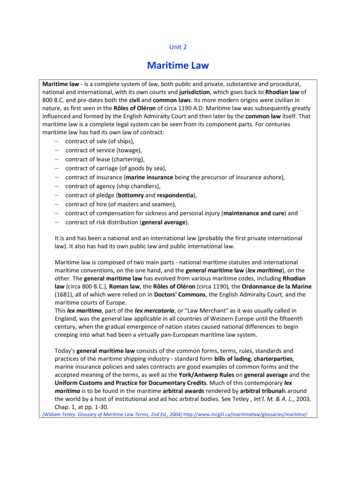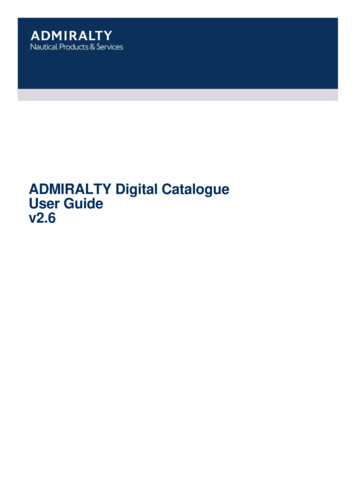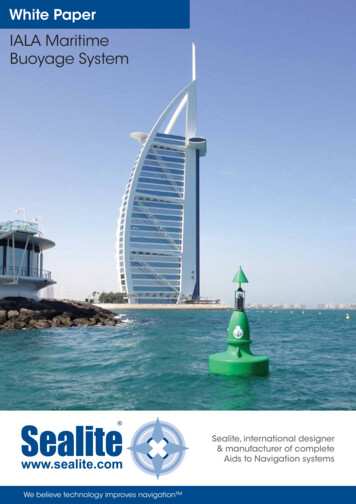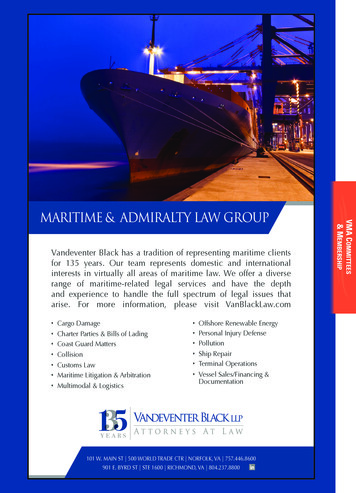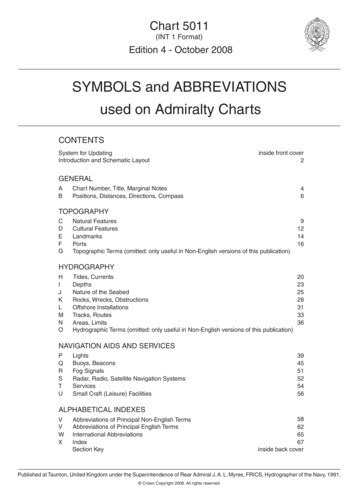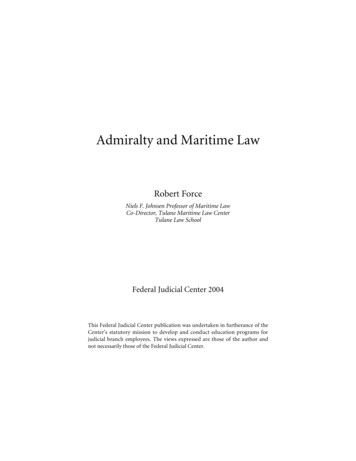
Transcription
Admiralty and Maritime LawRobert ForceNiels F. Johnsen Professor of Maritime LawCo-Director, Tulane Maritime Law CenterTulane Law SchoolFederal Judicial Center 2004This Federal Judicial Center publication was undertaken in furtherance of theCenter’s statutory mission to develop and conduct education programs forjudicial branch employees. The views expressed are those of the author andnot necessarily those of the Federal Judicial Center.
ContentsPreface ixChapter 1: Jurisdiction and Procedure in Admiralty and MaritimeCases 1Introduction 1Admiralty Jurisdiction in Tort Cases 3Navigable Waters of the United States 3The Admiralty Locus and Nexus Requirements 5Maritime Locus 5The Admiralty Extension Act 6Maritime Nexus 6Admiralty Jurisdiction in Contract Cases 9Mixed Contracts 11Multiple Jurisdictional Bases 12Rule 9(h) of the Federal Rules of Civil Procedure 12Multiple Claims 12The Saving to Suitors Clause 18Admiralty Cases in State Courts 18Admiralty Actions At Law in Federal Courts 18Law Applicable 19Removal 19Sources of Admiralty and Maritime Law 20The General Maritime Law 21Choice of Law: U.S. or Foreign 21Procedure in Admiralty Cases 27Special Admiralty Rules 28Types of Actions: In Personam, In Rem, Quasi In Rem 28The Complaint 34Security for Costs 34Property Not Within the District 34Necessity for Seizure and Retention—Exceptions 35Post-Arrest/Post-Attachment Hearing 36Release of Property—Security 36Increase or Decrease of Security; Counter-Security 38Restricted Appearance 38Sale of Property 39iii
Admiralty and Maritime LawChapter 2: Commercial Law 41Introduction 41Charter Parties 42Definition and Types 42The Contract 44Typical Areas of Dispute 44Withdrawal 50Subcharters 50Liability of the Owner for Damage or Loss of Goods 51Arbitration Clauses 51Transport Under Bills of Lading 52Introduction 52Legislation 54Bills of Lading Under the Pomerene Act 54Applicability 54Negotiable and Nonnegotiable Bills of Lading 54Carrier Obligation and Liability 55The Harter Act 56Applicability and Duration 56Prohibition of Exculpatory Clauses Under the Harter Act 56Carrier’s Defenses Under the Harter Act 57Unseaworthiness 58Carriage of Goods by Sea Act 58Scope and Application 58Parties to the Contract of Carriage: The COGSA Carrier 61Duration 63Carrier’s Duty to Issue Bills of Lading 63Carrier’s Duties Relating to Vessel and Cargo 64Exculpatory Clauses Prohibited 64Immunities of Carrier 65Deviation 73Damages and Limitation of Carrier’s Liability 74Burden of Proof 78Notice of Loss or Damage 79Time Bar 80Extending the Application of COGSA 80Jurisdiction and Choice-of-Law Clauses 82iv
ContentsChapter 3: Personal Injury and Death 83Introduction 83Damages 84Statute of Limitations 85Federal and State Courts 85Removal 85In Personam and In Rem Actions 86Seamen’s Remedies 86Introduction 86Maintenance and Cure 87Negligence: The Jones Act 91Unseaworthiness 99Contributory Negligence and Assumption of Risk in Jones Act andUnseaworthiness Actions 101Maritime Workers’ Remedies 102Longshore and Harbor Workers’ Compensation Act 102Scope of Coverage 102Remedies Under the LHWCA 106Dual-Capacity Employers 110Indemnity and Employer Liens 111Forum and Time for Suit 111Offshore Workers’ Remedies 112The Outer Continental Shelf Lands Act 112Remedies of Nonmaritime Persons 114Passengers and Others Lawfully Aboard a Ship 114Recreational Boating and Personal Watercraft 116Maritime Products Liability 117Remedies for Wrongful Death 117Introduction 117Death on the High Seas Act 118Wrongful Death Under the General Maritime Law 120Chapter 4: Collision and Other Accidents 125Introduction 125Liability 126Causation 126Presumptions 127Damages 128Pilots 131Place of Suit and Choice of Law 132v
Admiralty and Maritime LawChapter 5: Limitation of Liability 133Introduction 133Practice and Procedure 133The Limitation Fund 136Parties and Vessels Entitled to Limit 138Grounds for Denying Limitation: Privity or Knowledge 139Claims Subject to Limitation 140Choice of Law 141Chapter 6: Towage 143Towage Contracts 143Duties of Tug 144Duties of Tow 145Liability of the Tug and the Tow to Third Parties 146Exculpatory and Benefit-of-Insurance Clauses 146Chapter 7: Pilotage 149Introduction 149Regulation of Pilots 150Liability of Pilots and Pilot Associations 151Exculpatory Pilotage Clauses 152Chapter 8: Salvage 153Introduction 153Elements of “Pure Salvage” Claims 154Salvage and Finds Distinguished 156Salvage Awards 157Misconduct of Salvors 159Contract Salvage 160Life Salvage 161Chapter 9: Maritime Liens and Mortgages 163Liens 163Property to Which Maritime Liens Attach 164Custodia Legis 165Categories of Maritime Liens 165Contract Liens 166Preferred Ship Mortgage 168Liens for Necessaries 168vi
ContentsPersons Who May Acquire Maritime Liens 171Priorities of Liens 171Ranking of Liens 171Governmental Claims 174Conflicts of Laws 174Extinction of Maritime Liens 175Destruction or Release of the Res 175Sale of the Res 175Laches 176Waiver 177Bankruptcy 177Ship Mortgages 177Chapter 10: Marine Insurance 181Introduction: Federal or State Law 181Interpretation of Insurance Contracts 183Limitation of Liability 183Burden of Proof 183Insurable Interest 184Types of Insurance 184The Hull Policy 185Protection and Indemnity Insurance 187Pollution Insurance 187Cargo Insurance 188Subrogation 188Chapter 11: Governmental Liability and Immunity 189The Federal Government 189The Suits in Admiralty Act 189The Public Vessels Act 190The Federal Tort Claims Act 190State and Municipal Governments 191Foreign Governments: The Foreign Sovereign Immunities Act 192Chapter 12: General Average 195Introduction 195The General Average Loss: Requirements 195The York–Antwerp Rules 196General Average, Fault, and the New Jason Clause 197The General Average Statement 197vii
Admiralty and Maritime LawSelected Bibliography 199Cases 203Statutes 227Rules 235Index 237viii
PrefaceAs this monograph demonstrates, “admiralty and maritime law” covers a broad range of subjects. This field of law has its own rules relating to jurisdiction and procedure. Classically, maritime law was a species of commercial law, and in many countries it is still treated assuch. Thus, this monograph includes topics such as charter parties,carriage of goods, and marine insurance. There are also areas of maritime law that are peculiar to the subject matter. The law of collision,towage, pilotage, salvage, limitation of liability, maritime liens, andgeneral average are unique to maritime law. In addition, the UnitedStates has developed its own law of maritime personal injury anddeath. All references are to U.S. courts unless noted otherwise.I would like to thank Judge Eldon Fallon (U.S. District Court forthe Eastern District of Louisiana), Judge Sarah S. Vance (U.S. DistrictCourt for the Eastern District of Louisiana and member of the Boardof the Federal Judicial Center), and Judge W. Eugene Davis (U.S.Court of Appeals for the Fifth Circuit) for their invaluable assistancein reviewing the draft of this monograph.ix
chapter 1Jurisdiction and Procedure inAdmiralty and Maritime CasesIntroductionArticle III of the U.S. Constitution defines the boundaries of subjectmatter jurisdiction for the courts. Specifically, it extends the judicialpower of the United States to “all Cases of admiralty and maritimeJurisdiction.” This grant of judicial power has been implemented byCongress in 28 U.S.C. § 1333, which states that “The [United States]district courts shall have original jurisdiction, exclusive of the Courtsof the States, of (1) any civil case of admiralty or maritime jurisdiction . . . .” In current usage the terms “admiralty jurisdiction” and“maritime jurisdiction” are used interchangeably. The Constitutiondoes not enumerate the types of “matters” or “cases” that fall withinthe terms “admiralty and maritime jurisdiction.”The Admiralty Clause in Article III does not disclose or even provide the means for ascertaining whether a particular dispute is an admiralty or maritime case. This task has been performed primarily bythe courts and, to a lesser extent, by Congress. Also, the Constitutiondoes not specify the legal rules to apply in resolving admiralty andmaritime disputes. It does not even point to the sources of substantivelaw that judges should consult to derive such rules. This task also hasbeen performed primarily by the courts and, to some extent, by Congress. In this regard, federal courts have not merely created rules to fillgaps or to supplement legislation as they have in other areas; theyhave played the leading role in creating a body of substantive rulesreferred to as the “general maritime law.”1 Thus, as will be discussedlater, the power of federal courts to entertain cases that fall withinadmiralty and maritime jurisdiction has required courts, in the exer1. Robert Force, An Essay on Federal Common Law and Admiralty, 43 St. LouisU. L.J. 1367 (1999).1
Admiralty and Maritime Lawcise of their jurisdiction, to formulate and apply substantive rules toresolve admiralty and maritime disputes.No federal statute provides general rules for determining admiralty jurisdiction. No statute comprehensively enumerates the variouscategories of cases that fall within admiralty jurisdiction. With twoexceptions, the few instances where Congress has expressly conferredadmiralty jurisdiction on federal district courts always has been inconnection with the creation of a specific, new statutory right. Notable examples include the Limitation of Vessel Owner’s Liability Act,2the Ship Mortgage Act,3 the Death on the High Seas Act,4 the Suits inAdmiralty Act,5 the Public Vessels Act,6 the Outer Continental ShelfLands Act,7 and the Oil Pollution Act of 1990.8 By contrast, the Carriage of Goods by Sea Act9 and the Federal Maritime Lien Act10 makeno reference to admiralty jurisdiction. The Jones Act provides an action on the law side but is silent as to whether an action can bebrought in admiralty.11 The tort and indemnity provisions of theLongshore and Harbor Workers’ Compensation Act (LHWCA) likewise make no reference to admiralty jurisdiction. Congress has notspoken to jurisdiction over collision cases or cases involving towage,pilotage, or salvage. No statutes confer admiralty jurisdiction overmarine insurance disputes. With the exception of the Death on theHigh Seas Act (DOHSA), the Jones Act, and the LHWCA, Congresshas not addressed the substantive law of maritime personal injury anddeath claims, let alone the issue of jurisdiction over such claims.2. 46 U.S.C. app. § 183 (2000).3. 46 U.S.C. § 31301 (2000).4. 46 U.S.C. app. § 761 (2000).5. Id. § 741.6. Id. § 781.7. 43 U.S.C. § 1331 (2000).8. 33 U.S.C. § 2701 (2000).9. 46 U.S.C. app. § 1301 (2000).10. 46 U.S.C. § 31341 (2000).11. 46 U.S.C. app. § 688 (2000). The Jones Act, which provides for recovery forinjury to or death of a seaman, is discussed in greater detail, infra text accompanyingnotes 411–90.2
Chapter 1: Jurisdiction and Procedure in Admiralty and Maritime CasesIn addition to 28 U.S.C. § 1333, the Admiralty Extension Act12and the Great Lakes Act13 are the only instances where Congress hasenacted admiralty jurisdiction statutes that are not tied to a specificstatutorily created right. By and large it appears that Congress hasbeen content to allow the federal courts to define the limits of theiradmiralty jurisdiction.Admiralty Jurisdiction in Tort CasesNavigable Waters of the United StatesThere has never been any doubt that admiralty jurisdiction extends tothe high seas and the territorial seas.14 The same may not be said ofinland waters. Originally U.S. courts applied the English rules for determining admiralty jurisdiction. Those rules, however, would exclude from admiralty jurisdiction incidents and transactions involvingthe Great Lakes and inland waterways. In a series of cases, the U.S.Supreme Court overruled its earlier precedents and abandoned theEnglish rules as unsuited to the inland water transportation system ofthe United States.In place of the English rules, the U.S. Supreme Court equated thescope of admiralty jurisdiction with “navigable waters.”15 The term“navigable waters of the United States” is a term of art that refers tobodies of water that are navigable in fact. This includes waters used orcapable of being used as waterborne highways for commerce, including those presently sustaining or those capable of sustaining thetransportation of goods or passengers by watercraft. To qualify as“navigable waters,” bodies of water must “form in their ordinary condition by themselves, or by uniting with other waters, a continued12. Admiralty Extension Act, 46 U.S.C. app. § 740 (2000).13. Great Lakes Act of Feb. 26, 1845, ch. 20, 5 Stat. 726, 28 U.S.C. § 1873 (2000);Genesee Chief v. Fitzhugh, 53 U.S. (12 How.) 443, 451 (1851) (“The law, however,contains no regulations of commerce; nor any provision in relation to shipping andnavigation on the lakes. It merely confers a new jurisdiction on the district courts; andthis is its only object and purpose.”).14. Grant Gilmore & Charles L. Black, Jr., The Law of Admiralty, § 1-11 at 31(2d ed. 1975).15. Jackson v. The Steamboat Magnolia, 61 U.S. (20 How.) 296 (1857).3
Admiralty and Maritime Lawhighway over which commerce is or may be carried on with otherStates or foreign countries in the customary modes in which suchcommerce is conducted by water.”16A body of water that is completely land-locked within a singlestate is not navigable for purposes of admiralty jurisdiction. It is important to note, however, that a body of water need not flow betweentwo states or into the sea to be navigable. A body of water may benavigable even if it is located entirely within one state as long as itflows into another body of water that, in turn, flows into another stateor the sea. A body of water need only be a link in the chain of interstate or foreign commerce.17 Thus, if a small river located completelywithin a state flows into the Mississippi River, it satisfies the navigability requirement so long as its physical characteristics do not preclude it from sustaining commercial activity. Furthermore, it is notnecessary for commercial activity to be presently occurring as long asthe body of water is “capable” of sustaining commercial activity.18 Abody of water may be nonnavigable because obstructions, whethernatural or man-made, preclude commercial traffic from using thewaters as an interstate or international highway or link thereto.19 Removal of the obstruction may then make the waters navigable. Theconverse is true. A body of water may at one time have been navigableand have supported interstate or foreign commerce; however, theconstruction of dams or other obstructions may render certain portions of the waterway impassable to commercial traffic. If the obstruction precludes interstate or foreign commerce, the body of waterhas become nonnavigable and will not support admiralty jurisdiction.20 The fact that a body of water was historically navigable doesnot mean that it will remain so in the future.The term “navigable waters” may have legal relevance on issuesother than admiralty jurisdiction and may have different meaningsthat apply in other contexts. In Kaiser Aetna v. United States,21 the Su16.17.18.19.20.21.The Daniel Ball, 77 U.S. (10 Wall.) 557, 563 (1870).Id.LeBlanc v. Cleveland, 198 F.3d 353 (2d Cir. 1999).Id.Id.444 U.S. 164 (1979).4
Chapter 1: Jurisdiction and Procedure in Admiralty and Maritime Casespreme Court identified four separate purposes underlying the definitions of “navigability”: to delimit the boundaries of the navigationalservitude; to define the scope of Congress’s regulatory authority underthe Commerce Clause; to determine the extent of the authority of theArmy Corps of Engineers under the Rivers and Harbors Act; and toestablish the scope of federal admiralty jurisdiction.22Man-made bodies of water, such as canals, may qualify as navigable waters if they are capable of sustaining commerce and may be usedin interstate or foreign commerce.23 A body of water need not benavigable at all times, and some courts have recognized the doctrineof “seasonal navigability.”24 For example, a body of water may be usedfor interstate and foreign commerce during certain times of the yearbut may not support such activity during the winter when the waterfreezes. Events that occur during the period when the waterway is capable of being used may be subject to admiralty jurisdiction.The Admiralty Locus and Nexus RequirementsCurrently, in tort cases, the plaintiff must allege that the tort occurredon navigable waters and that the tort bore some relationship to traditional maritime activity.25 The first requirement is referred to as themaritime location or locus criterion and the second as the maritimenexus criterion.Maritime Locus“Maritime locus” is satisfied by showing that the tort occurred onnavigable waters.26 Thus, maritime locus is present where a person onshore discharges a firearm and wounds a person on a vessel in naviga-22. Id. at 171.23. In re Boyer, 109 U.S. 629 (1884).24. Wilder v. Placid Oil Co., 611 F. Supp. 841 (W.D. La. 1985). See also Missouriv. Craig, 163 F.3d 482 (8th Cir. 1998); Gollatte v. Harrell, 731 F. Supp. 453 (S.D. Ala.1989).25. Jerome B. Grubart, Inc. v. Great Lakes Dredge & Dock Co., 513 U.S. 527(1995).26. The Plymouth, 70 U.S. 20 (1865).5
Admiralty and Maritime Lawble waters.27 Locus is similarly present where a person injured on avessel in navigable waters subsequently dies following surgery to treatthe injury in a hospital on land.28The Admiralty Extension ActCongress expanded the maritime location test by enacting the Admiralty Extension Act (AEA),29 which confers on the federal courts admiralty jurisdiction over torts committed by vessels in navigable waters notwithstanding the fact that the injury or damage was sustainedon land. The AEA was enacted specifically to remedy situations referred to as allisions, where vessels collide with objects fixed to theland, such as bridges that span navigable waterways.The language of the AEA, however, is not limited to ship–bridgeallisions. In one of the most extreme situations, maritime jurisdictionwas found under the AEA in a case where a “booze cruise” passenger,after disembarking the vessel, was injured in an automobile accidentcaused by the driver of another car who allegedly became drunk whilealso a passenger on the cruise.30 It is crucial to AEA jurisdiction thatthe injury emanate from a vessel in navigable waters. The mere factthat a vessel may be involved in an activity is not enough. The partywho invokes jurisdiction under the AEA must show vessel negligence.Vessel negligence relates not only to defective appurtenances or negligent navigation, but to any tortious conduct of the crew while onboard the vessel that results in injury on land.Maritime NexusThe maritime nexus criterion is of relatively recent origin, and itsmeaning is still being developed. It was created by the Supreme Courtto restrict the scope of admiralty tort jurisdiction for various policyreasons, not the least of which are considerations of federalism and adesire to confine the exercise of admiralty jurisdiction to situations27.(1974).28.29.30.Kelly v. Smith, 485 F.2d 520 (5th Cir. 1973), cert. denied, 416 U.S. 969Motts v. M/V Green Wave, 210 F.3d 565 (5th Cir. 2000).46 U.S.C. app. § 740 (2000).Duluth Superior Excursions, Inc. v. Makela, 623 F.2d 1251 (8th Cir. 1980).6
Chapter 1: Jurisdiction and Procedure in Admiralty and Maritime Casesthat implicate national interests. “Maritime nexus” is satisfied bydemonstrating (1) that “the incident has ‘a potentially disruptive impact on maritime commerce’” and (2) that “‘the general character’ ofthe ‘activity giving rise to the incident’ shows a ‘substantial relationship to traditional maritime activity.’”31The nexus requirement evolved from four Supreme Court cases.The first case, Executive Jet Aviation, Inc. v. City of Cleveland,32 heldthat federal courts lacked admiralty jurisdiction over an aviation tortclaim where a plane during a flight wholly within the U.S. crashed inLake Erie.33 Although maritime locus was present, the Court excludedadmiralty jurisdiction because the incident was “only fortuitously andincidentally connected to navigable waters” and bore “no relationshipto traditional maritime activity.”34 The Court supplemented the maritime locus test by adding a nexus requirement that “the wrong bear asignificant relationship to traditional maritime activity.”35 In the second case, Foremost Insurance Co. v. Richardson,36 the Court made thenexus criterion a general rule of admiralty tort jurisdiction and heldthat admiralty tort jurisdiction extended to a collision between twopleasure boats. The third case, Sisson v. Ruby,37 confirmed that a vesselneed not be engaged in commercial activity or be in navigation, andextended tort jurisdiction to a fire on a pleasure boat berthed at a pier.The fourth and last case to address tort jurisdiction is Jerome B.Grubart, Inc. v. Great Lakes Dredge & Dock Co.38 Workers on a bargein the Chicago River were replacing wooden pilings that protectedbridges from being damaged by ships, and the workers undermined atunnel that ran under the river. Subsequently the tunnel collapsed andwater flowed from the river into the “Loop” (the Chicago business31. Jerome B. Grubart, Inc. v. Great Lakes Dredge & Dock Co., 513 U.S. 527, 534(1995) (citing Sisson v. Ruby, 497 U.S. 358, 364, n.2, 365 (1990)).32. 409 U.S. 249 (1972).33. The Court declined to hold that admiralty jurisdiction could never extend toan aviation tort. Id. at 271–72.34. Id. at 273.35. Id. at 268.36. 457 U.S. 668 (1982).37. 497 U.S. 358 (1990).38. 513 U.S. 527 (1995).7
Admiralty and Maritime Lawdistrict), causing extensive property damage and loss of business. Refining the previous three cases, the Court articulated the latest versionof the nexus criterion: The plaintiff must show that the tort arose outof a traditional maritime activity.39 This, in turn, requires a showing(1) that the tort have a potentially disruptive effect on maritimecommerce and (2) that the activity was substantially related to traditional maritime activity.40 The first factor is not applied literally to thefacts at hand; rather, the facts are viewed “at an intermediate level ofpossible generality.”41 The Court focused only on the “general features” of the incident, which it described as “damage by a vessel innavigable water to an underwater structure.”42 Damage to a structurebeneath a waterway could disrupt the waterway itself and disrupt thenavigational use of the waterway. Such an incident could adverselyaffect river traffic, and in this case it did. River traffic actually ceased,stranding ferryboats and preventing barges from entering the riversystem. Applying the second factor, the Court focused on whether thegeneral character of the activity giving rise to the incident reveals asubstantial relationship to traditional maritime activity. As the Courtsaid: “We ask whether a tortfeasor’s activity, commercial or noncommercial, on navigable waters is so closely related to activity traditionally subject to admiralty law that the reasons for applying specialadmiralty rules would apply in the suit at hand.”43 Observing that therequisite relationship was found in Foremost (navigation of vessel)and Sisson (docking of vessels), the Court similarly found that repairand maintenance work on a navigable waterway performed from avessel met the test.There are several clues as to where the Court may be going withthe nexus test, especially in torts involving vessels. The parties in thedamage actions who opposed admiralty jurisdiction in Grubart hadargued that applying the nexus test by looking at “general features”rather than the actual facts would mean that any time a vessel in navigable waters was involved in a tort the two criteria will be met. The39.40.41.42.43.Id. at 534.Id.Id. at 538.Id. at 539.Id. at 539–40.8
Chapter 1: Jurisdiction and Procedure in Admiralty and Maritime Casesmajority responded by stating that “this is not fatal criticism,”44 andthe concurring opinion observed that inasmuch as Executive Jet formulated a rule to deal with airplane crashes, no complex nexus testshould be required where a tort involves a vessel on navigable waters.45 Ultimately, the locus test may once again become the sole criterion in tort cases involving vessels.It would appear that after Grubart it is inappropriate for a courtto use any test for nexus other than the criteria approved in that case.In the aftermath of Executive Jet, lower federal courts had attemptedto fine-tune the nexus requirement; many courts of appeals followedthe lead of the Fifth Circuit, which formulated four factors to be applied in determining if the maritime nexus requirement was satisfied.46 The Supreme Court, however, indicated its disapproval of thesefactors47 and ultimately expressly rejected them.48Admiralty Jurisdiction in Contract CasesIn contract cases, courts have not used the locus and nexus criteria,but have focused instead on the subject matter of the contract. Onecommentator suggests the following approach for determining admiralty contract jurisdiction:In general, a contract relating to a ship in its use as such, or tocommerce or navigation on navigable waters, or to transportationby sea or to maritime employment is subject to maritime law andthe case is one of admiralty jurisdiction, whether the contract is tobe performed on land or water.A contract is not considered maritime merely because the services to be performed under the contract have reference to a ship orto its business, or because the ship is the object of such services or44. Id. at 542.45. Id. at 550, 551 (Thomas, J., and Scalia, J., concurring).46. Kelly v. Smith, 485 F.2d 520 (5th Cir. 1973), cert. denied, 416 U.S. 969(1974). Subsequently these four factors were supplemented by several others. Molettv. Penrod Drilling Co., 826 F.2d 1419 (5th Cir. 1987), cert. denied, 493 U.S. 1003(1989).47. Sisson v. Ruby, 497 U.S. 358 (1990).48. Grubart, 513 U.S. at 544.9
Admiralty and Maritime Lawthat it has reference to navigable waters. In order to be consideredmaritime, there must be a direct and substantial link between thecontract and the operation of the ship, its navigation, or its management afloat, taking into account the needs of the shipping industry, for the very basis of the constitutional grant of admiralty jurisdiction was to ensure a national uniformity of approach to worldshipping.49However, some contract cases have formulated jurisdictional distinctions that defy logic. Consider the following contracts that have beenheld to lie within admiralty jurisdiction:Suits on contracts for the carriage of goods and passengers; forthe chartering of ships (charter parties); for repairs, supplies, etc.,furnished to vessels, and for services such as towage, pilotage,wharfage; for the services of seamen and officers; for recovery ofindemnity or premiums on marine insurance policies.50Compare the foregoing with the following that have been held notto be within admiralty jurisdiction: “Suits on contracts for the building and sale of vessels; for the payment of a fee for procuring a charter; for services to a vessel laid up and out of navigation.”51 A mortgage on a vessel was not deemed by courts to be a maritime contractuntil Congress so provided.52Although it is not without dispute, executory contracts may satisfy admiralty jurisdiction, notwithstanding the fact that breaches ofsuch contracts do not give rise to maritime liens.53 However, it appears that so-called “preliminary” contracts are not maritime contracts.54 The criterion for determining which contracts are preliminarycontracts is not perfectly clear. Generally, when a contract necessitatesor contemplates the formation of a subsequent contract that will directly affect the vessel, the first contract is characterized as a prelimi49. Steven F. Friedell, 1 Benedict on Admiralty § 182, at 12-4 to 12-6 (7th rev.ed. 1999).50. Gilmore & Black, supra note 14, § 1-10, at 22.51. Id. at 26.52. Id. at 27.53. Terminal Shipping Co. v. Hamberg, 222 F. 1020 (D. Md. 1915).54. Peralta Shipping Corp. v. Smith & Johnson (Shipping) Corp., 739 F.2d 798(2d Cir. 1984), cert. denied, 470 U.S. 1031 (1985).10
Chapter 1: Jurisdiction and Procedure in Admiralty and Maritime Casesnary contract. Examples of contracts that have been deemed preliminary include contracts to supply a crew55 and to procure insurance.56At one time, it was thought that “agency” agreements were preliminary contracts. The Supreme Court, however, has rejected this per serule that deemed all agency contracts to be nonmaritime contracts. Inthe case before it, the Court held that a carrier’s failure to pay forbunkers (fuel oil) was a breach of a maritime contract, even thoughthe obligation to supply fuel stemmed from a “requirements” contractand the supplier (an oil company) contracted with another oil company to supply the oil in question.57 The oil company had undertakento supply oil to a vessel, and it did not matter how the oil companyarranged to satisfy its contractual obligation. Thus, it appears thatcontracts that obligate a person to provide services directly to a vesselmay be maritime contracts as distinguished from ones in which aperson merely obligates himself to procure another to provide servicesto a vessel. In any event, the Supreme Court has indicated that thedetermination as to whether agency contracts are maritime or notshould be made on a case-by-case basis.Mixed ContractsSome contracts may have aspects that satisfy the maritime requirement for admiralty jurisdiction, and yet there may be aspects of thecontract that are clearly nonmaritime. For example, a contract maycall for both ocean and overland transport. A mixed contract is not anadmiralty contract unless the nonmaritime aspect of the contract ismerely incidental
ing to jurisdiction and procedure. Classically, maritime law was a spe-cies of commercial law, and in many countries it is still treated as such. Thus, this monograph includes topics such as charter parties, carriage of goods, and marine insurance. There are also areas of mari-time law that are peculiar to t
